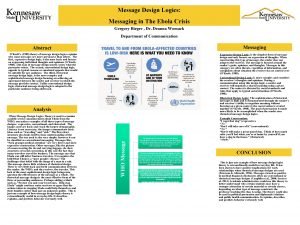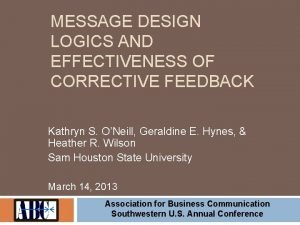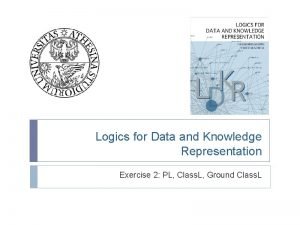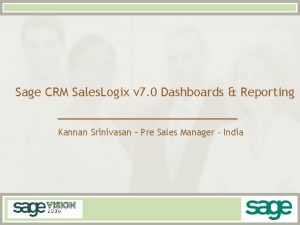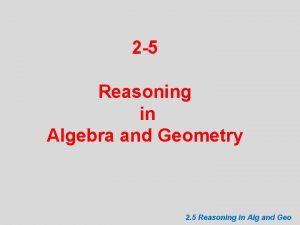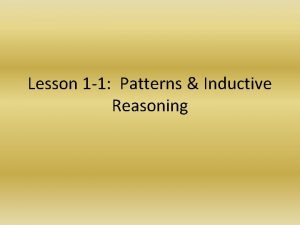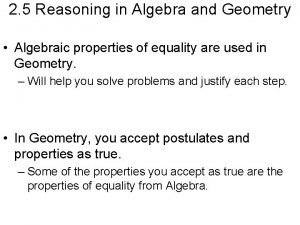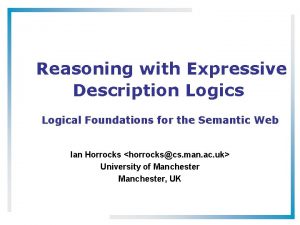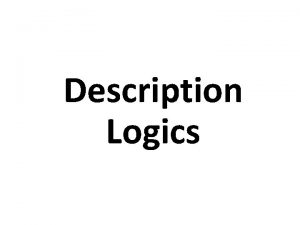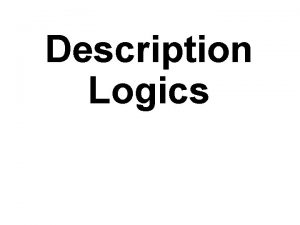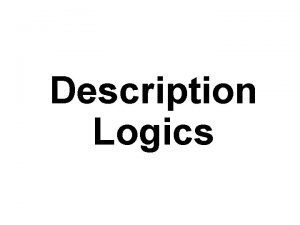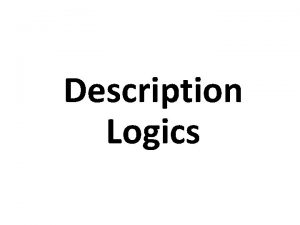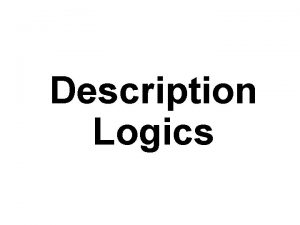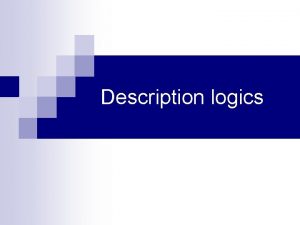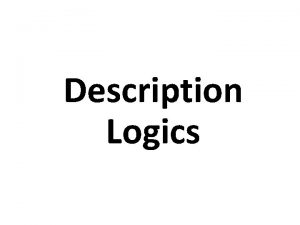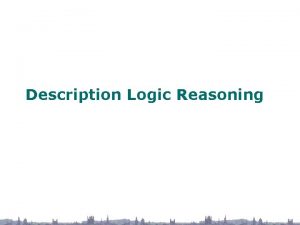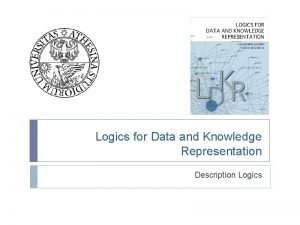Reasoning with Expressive Description Logics Theory and Practice





![Where we are Today: the Syntactic Web [Hendler & Miller 02] Where we are Today: the Syntactic Web [Hendler & Miller 02]](https://slidetodoc.com/presentation_image/319e2b017751fdf167bc2b578c88c6d5/image-6.jpg)









- Slides: 15

Reasoning with Expressive Description Logics Theory and Practice Ian Horrocks and Sean Bechhofer <horrocks|seanb@cs. man. ac. uk> University of Manchester, UK

Talk Outline • A Brief Introduction to the Semantic Web • An Introduction to Description Logics • Reasoning with OWL – Why did that happen? • Description Logic Reasoning – How did that happen? • Using Reasoning in Ontology Design • Research Challenges

A Brief Introduciton to the Semantic Web

History of the Semantic Web • • Web was “invented” by Tim Berners-Lee (amongst others), a physicist working at CERN TBL’s original vision of the Web was much more ambitious than the reality of the existing (syntactic) Web: “. . . a goal of the Web was that, if the interaction between person and hypertext could be so intuitive that the machine-readable information space gave an accurate representation of the state of people's thoughts, interactions, and work patterns, then machine analysiscould become a very powerful management tool, seeing patterns in our work and facilitating our working together through the typical problems which beset the management of large organizations. ” • TBL (and others) have since been working towards realising this vision, which has become known as the Semantic Web – E. g. , article in May 2001 issue of Scientific American…

! pe Scientific American, May 2001: w e B • • e ar f o e th y H Realising the complete “vision” is too hard for now (probably) But we can make a start by adding semantic annotation to web resources
![Where we are Today the Syntactic Web Hendler Miller 02 Where we are Today: the Syntactic Web [Hendler & Miller 02]](https://slidetodoc.com/presentation_image/319e2b017751fdf167bc2b578c88c6d5/image-6.jpg)
Where we are Today: the Syntactic Web [Hendler & Miller 02]

Hard Work using the Syntactic Web… Find images of Peter Patel-Schneider, Frank van Harmelen and Alan Rector… Rev. Alan M. Gates, Associate Rector of the Church of the Holy Spirit, Lake Forest, Illinois

Impossible (? ) using the Syntactic Web… • Complex queries involving background knowledge – Find information about “animals that use sonar but are neither bats nor dolphins” , e. g. , Barn Owl • Locating information in data repositories – Travel enquiries – Prices of goods and services – Results of human genome experiments • Finding and using “web services” – Visualise surface interactions between two proteins • Delegating complex tasks to web “agents” – Book me a holiday next weekend somewhere warm, not too far away, and where they speak French or English

What is the Problem? • Consider a typical web page: • Markup consists of: – rendering information (e. g. , font size and colour) – Hyper-links to related content • Semantic content is accessible to humans but not (easily) to computers… • Requires (at least) NL understanding

Adding “Semantics” • External agreement on meaning of annotations – E. g. , Dublin Core • Agree on the meaning of a set of annotation tags – Problems with this approach • Inflexible • Limited number of things can be expressed • Use Ontologies to specify meaning of annotations – – Ontologies provide a vocabulary of terms New terms can be formed by combining existing ones Meaning (semantics) of such terms is formally specified Can also specify relationships between terms in multiple ontologies

A Semantic Web — First Steps Make web resources more accessible to automated processes • Extend existing rendering markup with semantic markup – Metadata annotations that describe content/funtion of web accessible resources • Use Ontologies to provide vocabulary for annotations – “Formal specification” is accessible to machines • A prerequisite is a standard web ontology language – Need to agree common syntax before we can share semantics – Syntactic web based on standards such as HTTP and HTML

Ontology Design and Deployment • Given key role of ontologies in the Semantic Web, it will be essential to provide tools and services to help users: – Design and maintain high quality ontologies, e. g. : • Meaningful — all named classes can have instances • Correct — captured intuitions of domain experts • Minimally redundant — no unintended synonyms • Richly axiomatised — (sufficiently) detailed descriptions – Store (large numbers) of instances of ontology classes, e. g. : • Annotations from web pages – Answer queries over ontology classes and instances, e. g. : • Find more general/specific classes • Retrieve annotations/pages matching a given description – Integrate and align multiple ontologies

Web Ontology Language Requirements Desirable features identified for Web Ontology Language: • Extends existing Web standards – Such as XML, RDFS • Easy to understand use – Should be based on familiar KR idioms • Formally specified • Of “adequate” expressive power • Possible to provide automated reasoning support

From RDF to OWL • Two languages developed to satisfy above requirements – OIL: developed by group of (largely) European researchers (several from EU Onto. Knowledge project) – DAML-ONT: developed by group of (largely) US researchers (in DARPA DAML programme) • Efforts merged to produce DAML+OIL – Development was carried out by “Joint EU/US Committee on Agent Markup Languages” – Extends (“DL subset” of) RDF • DAML+OIL submitted to W 3 C as basis for standardisation – Web-Ontology (Web. Ont) Working Group formed – Web. Ont group developed OWL language based on DAML+OIL – OWL language now a W 3 C Candidate Recommendation – Will soon become Proposed Recommendation

OWL Language • Three species of OWL – OWL full is union of OWL syntax and RDF – OWL DL restricted to FOL fragment (¼ DAML+OIL) – OWL Lite is “simpler” subset of OWL DL • Semantic layering – OWL DL ¼ OWL full within DL fragment • OWL DL based on SHIQ Description Logic – In fact it is equivalent to SHOIN(Dn) DL • OWL DL Benefits from many years of DL research – – Well defined semantics Formal properties well understood (complexity, decidability) Known reasoning algorithms Implemented systems (highly optimised)
 Message design logics
Message design logics Kr logics
Kr logics Message design logics
Message design logics Sage crm saleslogix
Sage crm saleslogix Q logics
Q logics Sales logics crm
Sales logics crm Difference of inductive and deductive reasoning
Difference of inductive and deductive reasoning Deductive thinking
Deductive thinking Inductive reasoning moves from
Inductive reasoning moves from Deductive vs inductive reasoning
Deductive vs inductive reasoning Deductive reasoning examples
Deductive reasoning examples Inductive vs deductive geometry
Inductive vs deductive geometry Patterns and inductive reasoning
Patterns and inductive reasoning Reasoning in algebra and geometry
Reasoning in algebra and geometry Practice 1-1 patterns and inductive reasoning
Practice 1-1 patterns and inductive reasoning Reasoning in algebra and geometry practice
Reasoning in algebra and geometry practice
